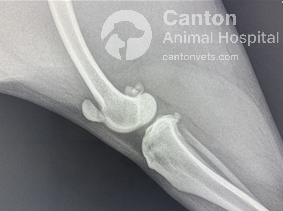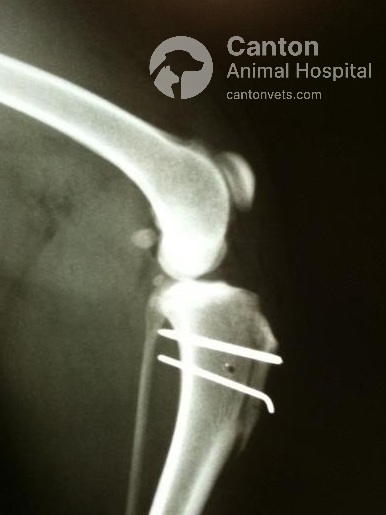Home | Surgeries | Patella Alta Surgery for Dogs
Patella Alta Surgery for Dogs
Patella Alta Surgery for Dogs
Patella Alta, or a high-riding patella, is a structural abnormality in which the patella sits too high within or above the trochlear groove of the femur. This misalignment results in knee instability, reduced joint function, and increased susceptibility to patellar luxation or cranial cruciate ligament (CCL) injury. Surgical intervention aims to correct patellar positioning, restore normal knee biomechanics, and prevent long-term joint degeneration.
Pathophysiology and Clinical Presentation
Patella Alta occurs due to congenital malformation, abnormal tibial growth patterns, or post-traumatic elongation of the patellar tendon. The condition disrupts the extensor mechanism of the stifle joint, resulting in altered biomechanics and joint instability.
Featured Resouces

We Welcome New Patients!
We're always happy to give your furry friend care at our hospital. Get in touch today!
Contact Us
Patella Alta occurs when the kneecap (patella) is positioned too high in relation to the femoral trochlear groove. This condition can lead to:
Frequent patellar dislocations (luxation)
Abnormal weight distribution on the knee joint
Increased risk of cranial cruciate ligament (CCL) rupture
Progressive arthritis due to chronic joint instability
Causes of Patella Alta
Congenital malformation – Some breeds, such as Greyhounds, Poodles, and Chihuahuas, have a genetic predisposition.
Developmental abnormalities – Improper bone growth in puppies can result in an elongated patellar tendon.
Post-Trauma Effects – Injury to the patellar tendon or femur may lead to an acquired high-riding patella.
Clinical Signs: Does Your Dog Have Patella Alta?
The symptoms of Patella Alta can vary depending on severity, but common signs include:
Intermittent or persistent lameness in one or both hind limbs
Knee instability or kneecap visibly shifting out of place
“Skipping” gait – dogs may occasionally hold the affected leg up when walking
Difficulty rising or jumping
Clicking or popping sounds from the knee joint
Muscle atrophy due to reduced leg use
If left untreated, Patella Alta can lead to arthritis and an increased risk of ACL (CCL) rupture.
Surgical Correction of Patella Alta
Surgical intervention is typically required for moderate to severe cases where lameness, pain, or knee instability is present. The primary goal of Patella Alta surgery is to realign the patella within the trochlear groove and restore normal knee function.
Surgical Techniques for Patella Alta Repair
1. Tibial Tuberosity Transposition (TTT)
The tibial tuberosity, where the patellar tendon attaches, is surgically repositioned to correct patellar alignment.
A small bone fragment is cut, shifted, and secured with pins or screws to lower the kneecap’s resting position.
2. Patellar Tendon Shortening
In cases where the patellar tendon is excessively long, a tendon shortening procedure may be performed to bring the patella into a normal position.
3. Trochleoplasty (Groove Deepening Surgery)
If the trochlear groove is shallow, it is surgically reshaped and deepened to better hold the patella in place.
4. Medial or Lateral Soft Tissue Adjustments
Soft tissue tightening procedures reinforce the correct positioning of the kneecap.
Release techniques may be performed if excessive tension is pulling the patella out of alignment.
5. Corrective Osteotomy for Severe Cases
Dogs with significant femoral or tibial deformities may require a femoral osteotomy to realign the knee joint entirely.

Post-Operative Recovery & Rehabilitation
Successful recovery from Patella Alta surgery requires strict post-operative management to promote proper healing and prevent complications.
Phase 1: Acute Healing (0-2 Weeks)
Activity restriction: crate rest or controlled confinement
Cold compression therapy to minimize swelling and inflammation
Multimodal pain management, including NSAIDs, opioids, and adjunctive therapies
Phase 2: Gradual Weight Bearing (2-6 Weeks)
Controlled leash walking to encourage appropriate weight distribution
Passive range-of-motion (PROM) exercises to prevent stiffness
No high-impact activity, jumping, or excessive flexion/extension
Phase 3: Strengthening & Rehabilitation (6-12 Weeks)
Structured physical therapy, including
hydrotherapy, laser therapy, and targeted muscle strengthening
Gradual return to normal function with increased activity levels
Final orthopedic assessment and radiographic follow-up at 8-12 weeks
Long-term prognosis is favorable in cases where early intervention prevents secondary joint degeneration, with most dogs achieving full return to function within 12-16 weeks post-surgery.
Potential Complications & Considerations
While Patella Alta surgery has a high success rate, potential post-operative complications include:
Patellar tendon inflammation (tendonitis)
Managed with physical therapy and controlled rehabilitation
Implant migration or failure: Rare but possible with excessive post-operative activity
Delayed bone healing: More common in older dogs or those with metabolic bone disorders
Fibrosis or restricted range of motion: Prevented through structured rehabilitation programs
Surgical success depends on preoperative planning, precise execution, and post-operative management, ensuring optimal long-term function.
Frequently Asked Questions (FAQ) About Patella Alta Surgery
Patella Alta—also known as a high-riding patella—is a congenital or acquired orthopedic condition in dogs where the kneecap sits too high in the femoral groove, leading to pain, instability, and an increased risk of patellar luxation or ligament damage.
Tips and Advice From Our Team
Our blog features helpful tips and educational material from our team to support your needs.
Featured Resouces

We Welcome New Patients!
We're always happy to give your furry friend care at our hospital. Get in touch today!
Contact Us




